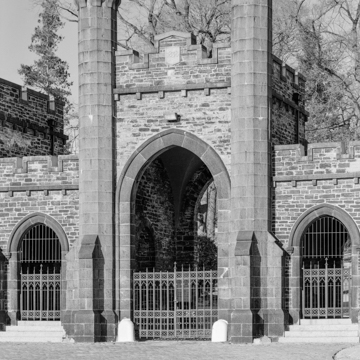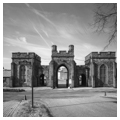This is among America’s earliest rural cemeteries, created from a landscape design by engineer Latrobe overlaid on tobacco merchant Robert Oliver’s former country estate by the same name. It was inspired by Mount Auburn Cemetery (1831) in Cambridge, Massachusetts, which launched a rural cemetery movement in America that quickly spread to other progressive urban areas. Characterized by their picturesque landscaping and artistic commemorative memorials, rural cemeteries were first established in response to overcrowded urban burial grounds and increased industrialization that imposed pressures on urban sanitation. Located on the urban fringes, rural cemeteries also provided urban dwellers a bucolic retreat. With their meandering paths and lush plantings, they offered a prototype for the American park movement begun in the mid-nineteenth century with Fairmount Park (1855) in Philadelphia and Central Park (1858) in New York City.
Green Mount consists of sixty-eight acres of picturesque landscaped grounds and funerary art surrounded by high stone walls, now located within the heart of east Baltimore. Its rolling hills and high elevation provide splendid vistas of the cityscape and is shaded by old-growth trees. Due to its exceptionally fine memorials and statuary, Green Mount can be seen as an outdoor sculpture garden that includes works by noted artists Hans Schuler, W. H. Rinehart, and Edward Berge, and with early gravestones and vaults by well-known local stonecutters Frederick Baughman and T. Horatio Bevan.
Among its significant structures is the Gothic Revival five-part gatehouse, a central portal with towers and single-story hyphens that connect to a flanking office and waiting room. The octagonal, cut-stone chapel features a spire that rises 102 feet, flying buttresses, pinnacles, lancet bays, and a porte-cochere. It replaced Robert Oliver’s house, initially used for that purpose. The superintendent and caretaker cottages, designed in the same mode, were likely built then as well. In 1929, a Classical Revival mausoleum ornamented with Art Deco and Egyptian motifs was erected. Among the many worthies buried at Green Mount are eight Maryland governors and seven city mayors; philanthropists Johns Hopkins, Enoch Pratt, Henry and William Walters, and Moses Sheppard; and industrialists Robert Garrett, Arunah Abell, Ross Winans, Alex Brown, and Robert Oliver.

















